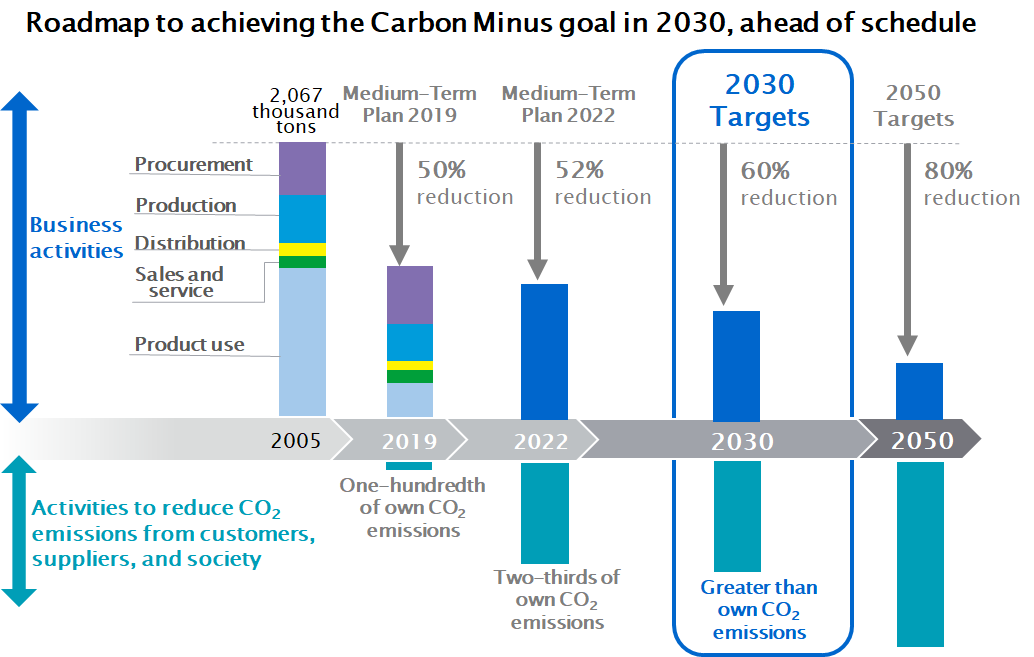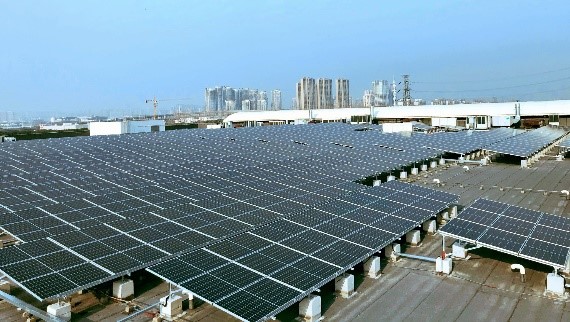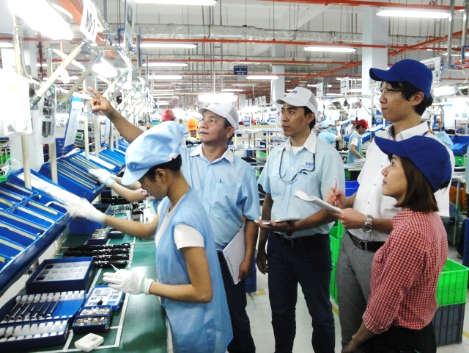News Releases
Konica Minolta to Achieve the Carbon Minus Goal in 2030,
Ahead of the Original Target Year of 2050
Striving for Drastic Reduction of CO2 Emissions with DX
July 31, 2020
Tokyo – Konica Minolta, Inc. (Konica Minolta) today announced that it has changed the target year to achieve the Carbon Minus goal stated in its Eco Vision 2050 from 2050 to 2030.
In 2017, Konica Minolta set a new goal of achieving the Carbon Minus status in 2050 in the Eco Vision 2050, a long-term environmental vision the company formulated in 2009. While Konica Minolta had been striving to reduce CO2 emissions from its products through their entire lifecycle (CO2 emissions produced by Konica Minolta’s business activities), the company launched new efforts to reduce CO2 emissions by more than the own CO2 emissions in collaboration with external stakeholders, including suppliers, customers and society, to attain this new goal.

To realize the Carbon Minus status by 2030, earlier than the original schedule of 2050, it is necessary to accelerate the process of reducing CO2 emissions from internal and external sources. Konica Minolta is confident that its digital transformation (DX) will be effective in drastically reducing CO2 emissions from both sources and enable the company to achieve the goal by 2030.
Initiatives towards Achieving the Carbon Minus Status
1. Internal Efforts
Konica Minolta is going to focus more on its Green Factory activities. Especially, assembly factories that work with many suppliers will benefit from digital manufacturing, which enables the factories to enhance their productivity and develop optimal production plans together with suppliers, thus helping to raise the energy efficiency. Konica Minolta is also promoting its Green Supplier activities to provide its expertise, advice and support to suppliers to help them reduce CO2 emissions. The company will thus build greater trust with suppliers and contribute to reducing CO2 emissions from external sources.
Konica Minolta has already achieved the goal of procuring 100% of electricity from renewable sources at its two factories in China and 43 offices in Europe. The company will continue efforts to source 100% renewable electricity for its global operations in a manner best suited to the local situation.

2. Efforts with Suppliers
Konica Minolta has been conducting the Green Supplier activities in which its experts visit suppliers’ factories to develop strategies to improve energy efficiency together and reduce CO2 emissions throughout the supply chain beyond Scope 3*. Suppliers also visit Konica Minolta’s factories to learn hands-on environmental initiatives and know-how. To effectively support more suppliers in their environmental efforts, Konica Minolta will offer an energy-saving diagnosis service on a digital platform instead of sending its experts to suppliers, so that suppliers can perform the entire process from assessing energy efficiency and identifying problems to taking action to improve their practices on their own. This service will also enable Konica Minolta to support more than 10 times as many suppliers as before.
Konica Minolta will also assist suppliers of its renewably powered Chinese MFP factories to shift to renewable sources by sharing the factories’ know-how on switching to renewable energy and prompting them to introduce renewable sources through cooperation with other suppliers in neighboring areas.

3. Efforts with Customers
Konica Minolta is promoting its business strategy combined with its sustainability management strategy. Therefore, the growth of the company’s operations directly helps solve environmental problems. Konica Minolta not only offers energy-efficient products to reduce CO2 emissions from customers’ sites, but also supports customers’ business operations and helps them enhance work efficiency and reduce environmental impacts by providing products and services that assist customers in digital transformation. These products and services include: on-demand digital package, label and textile printing solutions that drastically improve production processes; the digital workplace platform that enables customers to go paperless, work anywhere, and thus reform their conventional workstyle; and edge-based IoT solutions to promote workflow reforms.
Aware of the importance of tackling environmental problems industry-wide to drastically increase the problem-solving ability, Konica Minolta launched the Environmental Digital Platform in cooperation with 15 Japanese companies in June 2020 to share and expand environmental know-how among them and create new values together to enhance environmental management efficiency.
By itself, Konica Minolta can address global environmental challenges only to a limited extent, but by collaborating with external stakeholders, including suppliers, customers and society, it can make a greater contribution to environmental sustainability. Konica Minolta remains committed to reducing CO2 emissions to tackle the threat of climate change in cooperation with stakeholders and to enhancing corporate value together.
*Scope 3 is one of the categories of emissions used for calculating greenhouse gas (GHG) emissions defined in a global guideline, The Greenhouse Gas Protocol.
Scope 1: Direct GHG emissions from sources owned or controlled by the company
Scope 2: GHG emissions from electricity and other energies purchased and used by the company
Scope 3: GHG emissions from use of sold products and services not covered by Scope 1 and Scope 2, including emissions from production and transportation of raw materials and from use of the company’s products by customers
Correction: August 18, 2020
When the news release was published on July 31, 2020, it read “Konica Minolta has already achieved the goal of procuring 100% of electricity from renewable sources at its two factories in China and 43 sales companies in Europe.” There was an error in translation. 43 offices in Europe, not 43 sales companies, have already achieved the goal of procuring 100% of electricity from renewable sources.
